Abstract
The effects of combination chemotherapy with 5FU and BCNU on rats with dimethylhydrazine (DMH)-induced colon cancer were investigated in a long term survival study. Eighty Wistar rats received a colon cancer producing regimen on DMH (40 mg/kg body weight/week, subcutaneously for 10 weeks). After presenting with signs of colonic disease, all rats underwent diagnostic laparotomy and colonoscopy when colon tumours were located, measured and the extent of the disease staged. Only animals with tumours (n = 63) were included and allocated to one of three tumour stages. Stage A (n = 17), had colonic tumours without serosal involvement; stage B (n = 28) had serosal involvement without metastases; stage C (n = 18) had serosal involvement with lymphadenopathy and/or metastases. Each group was randomly allocated into two subgroups, one serving as untreated controls while the other received 5FU (300 mg/m2 weekly intragastrically for life) together with BCNU (40 mg/m2 intraperitoneally on days 0, 42 and 84). The effect of chemotherapy on tumour growth was measured sequentially by colonoscopy. Animals were observed until death and necropsied, when colon carcinoma was histologically confirmed and survival analysed. The results indicate that chemotherapy significantly prolongs the survival of rats with the least advanced disease (stage A) but was of no benefit to rats with locally advanced or metastatic disease (stages B and C). Furthermore, chemotherapy was associated with a significant reduction in tumour size. Survival analyses in untreated animals show that the laparotomy staging system adopted provides accurate prognostic information. This study shows that DMH-induced colon tumours are chemosensitive, and suggests that this animal model may be a valuable testing ground for new chemotherapeutic agents.
Full text
PDF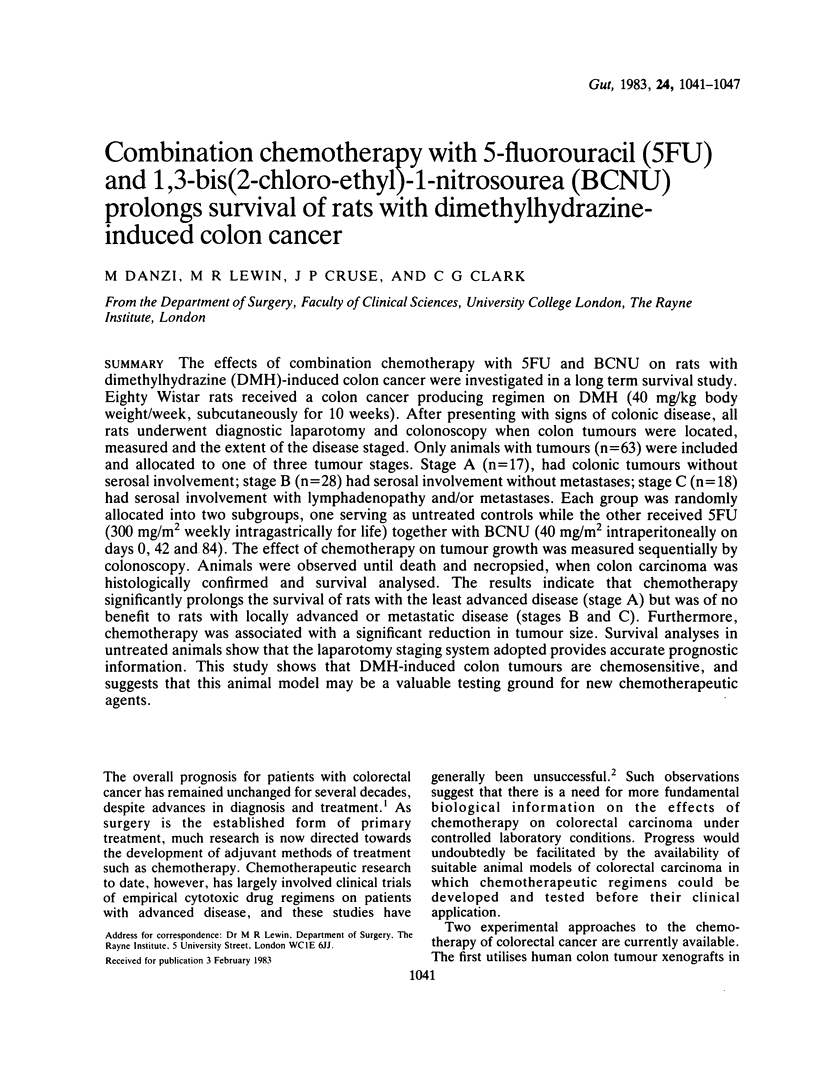
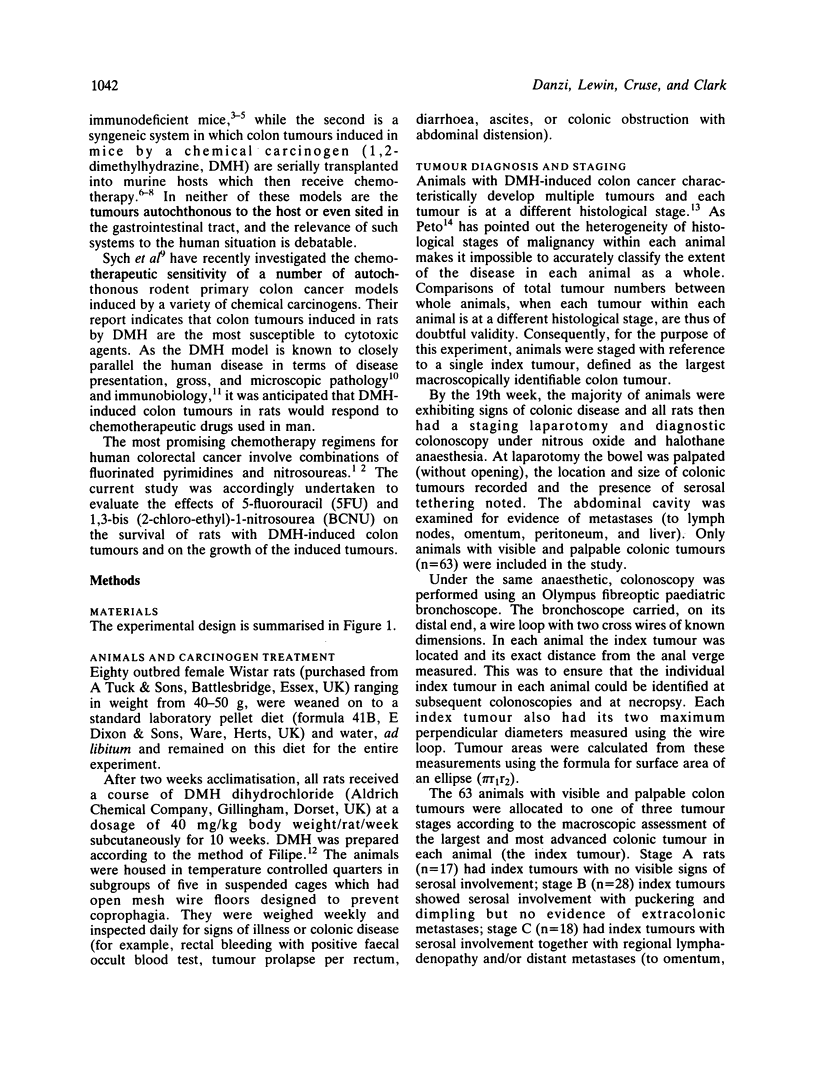
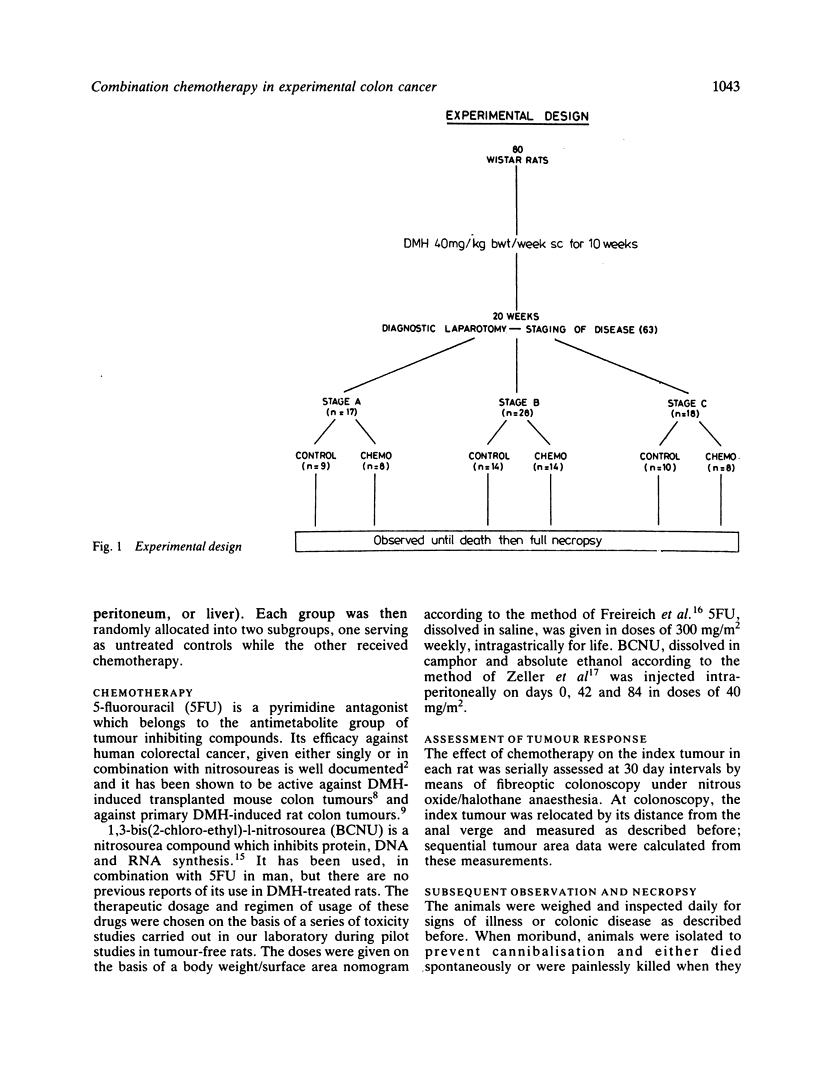
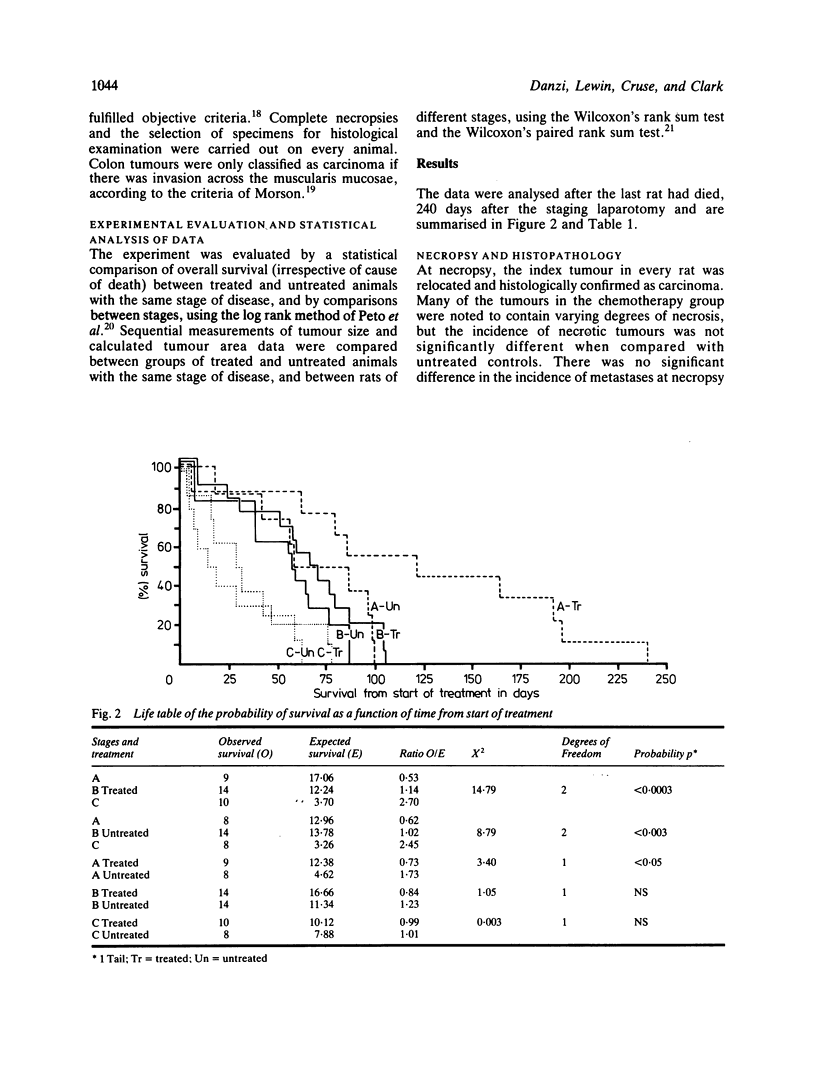
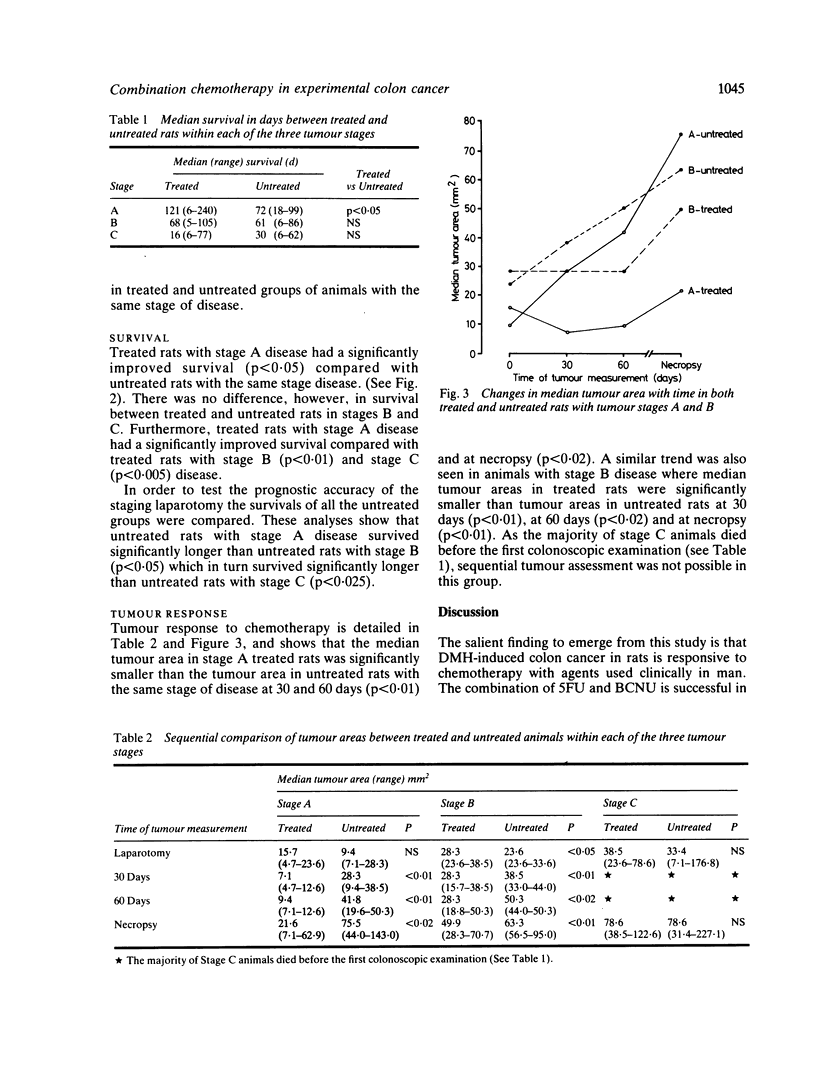
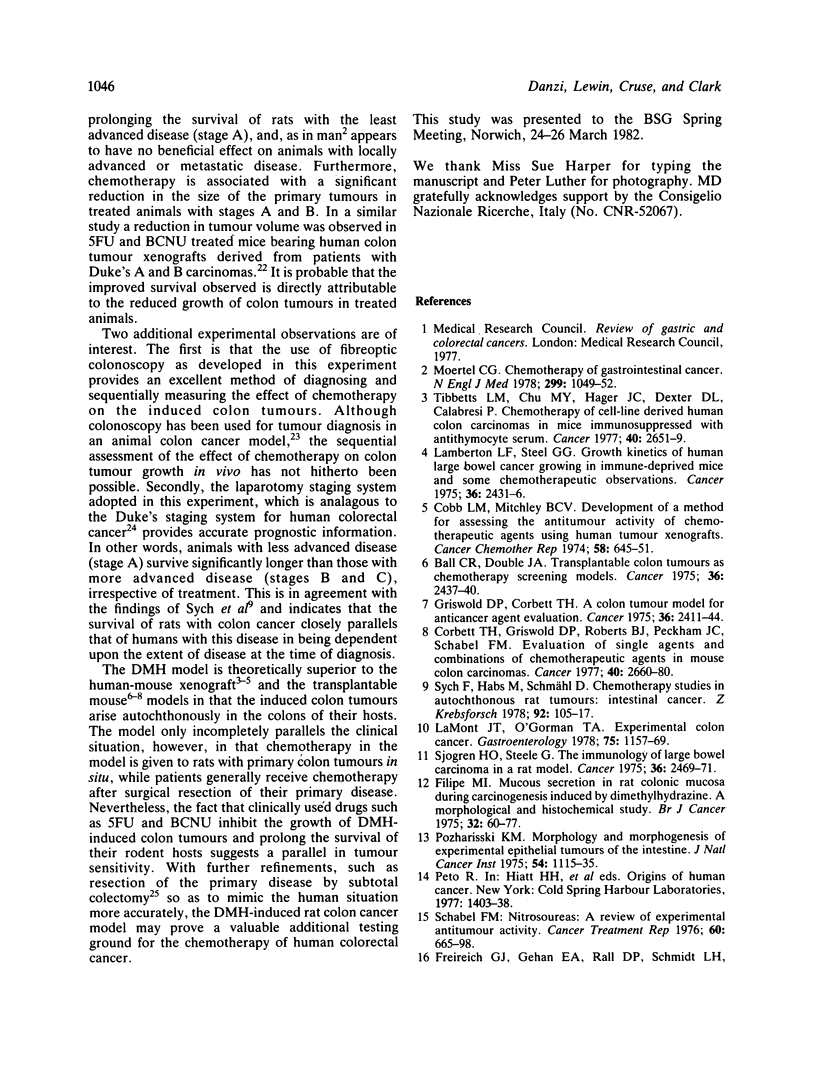
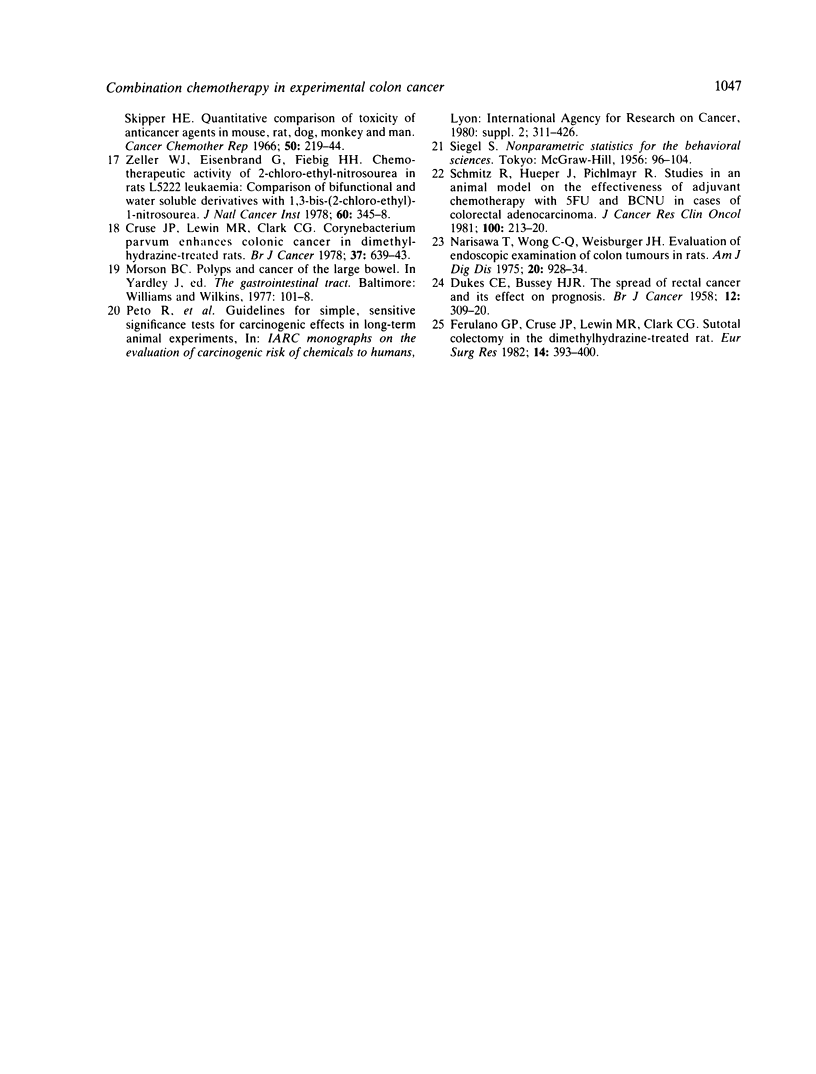
Selected References
These references are in PubMed. This may not be the complete list of references from this article.
- Ball C. R., Double J. A. Transplantable colon tumors as chemotherapy screening models. Cancer. 1975 Dec;36(6 Suppl):2437–2440. doi: 10.1002/1097-0142(197512)36:6<2437::aid-cncr2820360626>3.0.co;2-b. [DOI] [PubMed] [Google Scholar]
- Cobb L. M., Mitchley B. C. Development of a method for assessing the antitumor activity of chemotherapeutic agents using human tumor xenografts. Cancer Chemother Rep. 1974 Sep-Oct;58(5 Pt 1):645–651. [PubMed] [Google Scholar]
- Corbett T. H., Griswold D. P., Jr, Roberts B. J., Peckham J. C., Schabel F. M., Jr Evaluation of single agents and combinations of chemotherapeutic agents in mouse colon carcinomas. Cancer. 1977 Nov;40(5 Suppl):2660–2680. doi: 10.1002/1097-0142(197711)40:5+<2660::aid-cncr2820400940>3.0.co;2-m. [DOI] [PubMed] [Google Scholar]
- Cruse J. P., Lewin M. R., Clark C. G. Corynebacterium parvum enhances colonic cancer in dimethylhydrazine-treated rats. Br J Cancer. 1978 Apr;37(4):639–643. doi: 10.1038/bjc.1978.94. [DOI] [PMC free article] [PubMed] [Google Scholar]
- DUKES C. E., BUSSEY H. J. The spread of rectal cancer and its effect on prognosis. Br J Cancer. 1958 Sep;12(3):309–320. doi: 10.1038/bjc.1958.37. [DOI] [PMC free article] [PubMed] [Google Scholar]
- Ferulano G. P., Cruse J. P., Lewin M. R., Clark C. G. Subtotal colectomy in the dimethylhydrazine-treated rat. A surgical model of colorectal cancer. Eur Surg Res. 1982;14(6):393–400. doi: 10.1159/000128313. [DOI] [PubMed] [Google Scholar]
- Filipe M. I. Mucous secretion in rat colonic mucosa during carcinogenesis induced by dimethylhydrazine. A morphological and histochemical study. Br J Cancer. 1975 Jul;32(1):60–77. doi: 10.1038/bjc.1975.134. [DOI] [PMC free article] [PubMed] [Google Scholar]
- Freireich E. J., Gehan E. A., Rall D. P., Schmidt L. H., Skipper H. E. Quantitative comparison of toxicity of anticancer agents in mouse, rat, hamster, dog, monkey, and man. Cancer Chemother Rep. 1966 May;50(4):219–244. [PubMed] [Google Scholar]
- LaMont J. T., O'Gorman T. A. Experimental colon cancer. Gastroenterology. 1978 Dec;75(6):1157–1169. [PubMed] [Google Scholar]
- Lamerton L. F., Steel G. G. Growth kinetics of human large bowel cancer growing in immune-deprived mice and some chemotherapeutic observations. Cancer. 1975 Dec;36(6 Suppl):2431–2436. doi: 10.1002/1097-0142(197512)36:6<2431::aid-cncr2820360625>3.0.co;2-w. [DOI] [PubMed] [Google Scholar]
- Moertel C. G. Chemotherapy of gastrointestinal cancer. N Engl J Med. 1978 Nov 9;299(19):1049–1052. doi: 10.1056/NEJM197811092991906. [DOI] [PubMed] [Google Scholar]
- Narisawa T., Wong C. Q., Weisburger J. H. Evaluation of endoscopic examination of colon tumors in rats. Am J Dig Dis. 1975 Oct;20(10):928–934. doi: 10.1007/BF01070878. [DOI] [PubMed] [Google Scholar]
- Pozharisski K. M. Morphology and morphogenesis of experimental epithelial tumors of the intestine. J Natl Cancer Inst. 1975 May;54(5):1115–1135. doi: 10.1093/jnci/54.5.1115. [DOI] [PubMed] [Google Scholar]
- Schabel F. M., Jr Nitrosoureas: a review of experimental antitumor activity. Cancer Treat Rep. 1976 Jun;60(6):665–698. [PubMed] [Google Scholar]
- Schmitz R., Hüper J., Pichlmayr R. Studies in an animal model on the effectiveness of adjuvant chemotherapy with 5-FU and BCNU in cases of colorectal adenocarcinoma. J Cancer Res Clin Oncol. 1981;100(2):213–220. doi: 10.1007/BF00403367. [DOI] [PubMed] [Google Scholar]
- Sjögren H. O., Steele G., Jr The immunology of large bowel carcinoma in a rat model. Cancer. 1975 Dec;36(6 Suppl):2469–2471. doi: 10.1002/1097-0142(197512)36:6<2469::aid-cncr2820360632>3.0.co;2-d. [DOI] [PubMed] [Google Scholar]
- Sych F., Habs M., Schmähl D. Chemotherapy studies in autochthonous rat tumors intestinal cancer. Z Krebsforsch Klin Onkol Cancer Res Clin Oncol. 1978 Aug 24;92(1):105–117. doi: 10.1007/BF00284097. [DOI] [PubMed] [Google Scholar]
- Tibbetts L. M., Chu M. Y., Hager J. C., Dexter D. L., Calabresi P. Chemotherapy of cell-line-derived human colon carcinomas in mice immunosuppressed with antithymocyte serum. Cancer. 1977 Nov;40(5 Suppl):2651–2659. doi: 10.1002/1097-0142(197711)40:5+<2651::aid-cncr2820400939>3.0.co;2-v. [DOI] [PubMed] [Google Scholar]
- Zeller W. J., Eisenbrand G., Fiebig H. H. Chemotherapeutic activity of new 2-chloroethylnitrosoureas in rat L5222 leukemia: comparison of bifunctional and water-soluble derivatives with 1,3-bis(2-chloroethyl)-1-nitrosourea. J Natl Cancer Inst. 1978 Feb;60(2):345–348. doi: 10.1093/jnci/60.2.345. [DOI] [PubMed] [Google Scholar]


